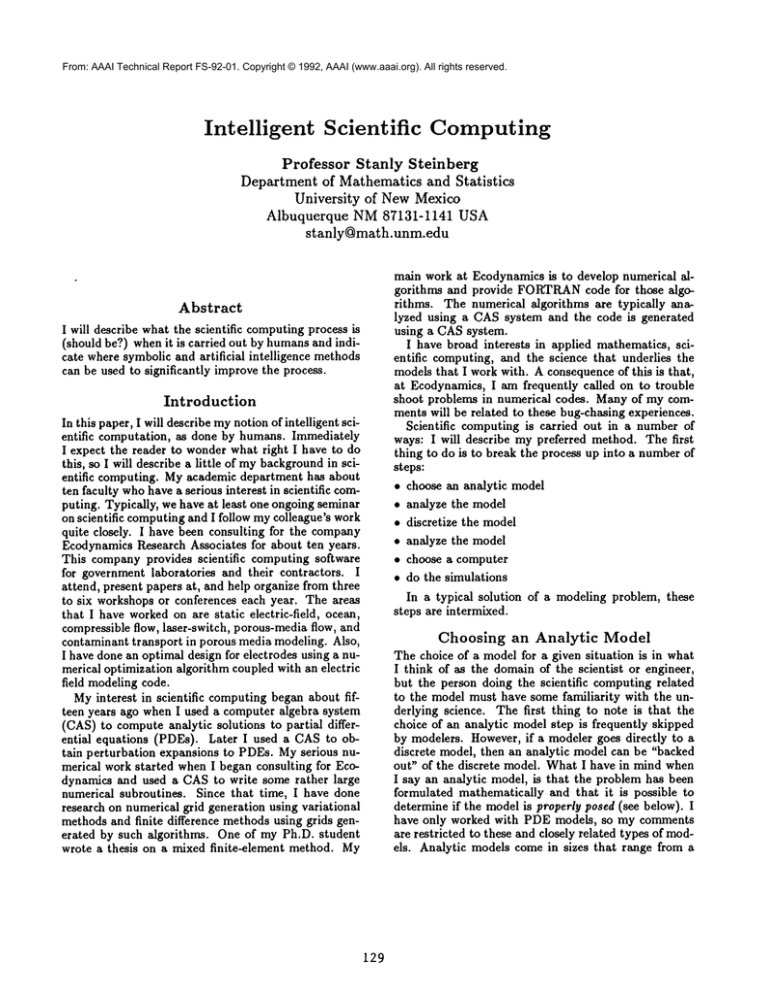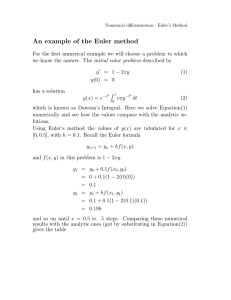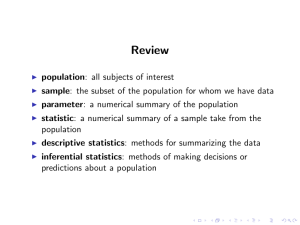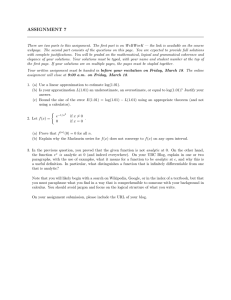
From: AAAI Technical Report FS-92-01. Copyright © 1992, AAAI (www.aaai.org). All rights reserved.
Intelligent
Scientific
Computing
Professor Stanly Steinberg
Departmentof Mathematicsand Statistics
University of NewMexico
Albuquerque NM87131-1141 USA
stanly@math.unm.edu
Abstract
I will describe what the scientific computingprocess is
(should be?) whenit is carried out by humansand indicate where symbolic and artificial intelligence methods
can be used to significantly improve the process.
Introduction
In this paper, I will describe mynotion of intelligent scientific computation, as done by humans. Immediately
I expect the reader to wonder what right I have to do
this, so I will describe a little of mybackgroundin scientific computing. Myacademic department has about
ten faculty whohave a serious interest in scientific computing. Typically, we have at least one ongoing seminar
on scientific computingand I follow mycolleague’s work
quite closely. I have been consulting for the company
Ecodynamics Research Associates for about ten years.
This company provides scientific computing software
for government laboratories and their contractors. I
attend, present papers at, and help organize from three
to six workshops or conferences each year. The areas
that I have workedon are static electric-field,
ocean,
compressible flow, laser-switch, porous-media flow, and
contaminant transport in porous media modeling. Also,
I have done an optimal design for electrodes using a numerical optimization algorithm coupled with an electric
field modelingcode.
Myinterest in scientific computing began about fifteen years ago when I used a computer algebra system
(CAS) to compute analytic solutions to partial differential equations (PDEs). Later I used a CASto obtain perturbation expansions to PDEs. Myserious numerical work started when I began consulting for Ecodynamics and used a CASto write some rather large
numerical subroutines. Since that time, I have done
research on numerical grid generation using variational
methods and finite difference methods using grids generated by such algorithms. One of my Ph.D. student
wrote a thesis on a mixed finite-element method. My
129
main work at Ecodynamics is to develop numerical algorithms and provide FORTRAN
code for those algorithms. The numerical algorithms are typically analyzed using a CASsystem and the code is generated
using a CASsystem.
I have broad interests in applied mathematics, scientific computing, and the science that underlies the
models that I work with. A consequence of this is that,
at Ecodynamics, I am frequently called on to trouble
shoot problems in numerical codes. Many of my comments will be related to these bug-chasing experiences.
Scientific computing is carried out in a number of
ways: I will describe my preferred method. The first
thing to do is to break the process up into a number of
steps:
¯ choose an analytic model
¯ analyze the model
¯ discretize the model
¯ analyze the model
¯ choose a computer
¯ do the simulations
In a typical solution of a modeling problem, these
steps are intermixed.
Choosing
an Analytic
Model
The choice of a model for a given situation is in what
I think of as the domain of the scientist or engineer,
but the person doing the scientific computing related
to the model must have some familiarity with the underlying science. The first thing to note is that the
choice of an analytic model step is frequently skipped
by modelers. However, if a modeler goes directly to a
discrete model, then an analytic model can be "backed
out" of the discrete model. What I have in mind when
I say an analytic model, is that the problem has been
formulated mathematically and that it is possible to
determine if the model is properly posed (see below).
have only worked with PDE models, so my comments
are restricted to these and closely related types of models. Analytic models come in sizes that range from a
From: AAAI Technical Report FS-92-01. Copyright © 1992, AAAI (www.aaai.org). All rights reserved.
few algebraic equations and, perhaps, an ordinary differential equation, to those that involve a system of five
to ten PDEsin three space dimensions and time.
An important point here is that analytic models are
more accurate than the numerical models. That is, for
complicated problems, analytic results provide more accurate descriptions of the system being modeled than
can be provided by discrete models using the largest
computers. Moreover, the mathematical properties of
the analytic model more accurately represent important properties of the system being modeled than do
the mathematical properties of the discrete model. For
example, numerical effects, such as loss of conservation, diffusion, and dispersion quickly swampthe related physical properties, while in analytic modelsthese
effects can be set to zero, which for the relevant systems is an accurate approximation. Thus a typical goal
of scientific computingis to accurately approximate an
analytic model.
Analyzing
the Analytic
Model
An analytic model is properly posed if conditions such
as the following are satisfied:
¯ there are the same number of PDEsas unknownfunctions
¯ there are as many initial conditions for an unknown
function as the highest number of time derivatives of
that functions appearing in the PDEs
¯ there are a "proper" number of boundary conditions
¯ the dependencies and units of all variable are known
¯ etc.
The point here is to "formally" guarantee that the
model problem has a unique solution (or at least one
solution and at most a finite number of solutions). If
this is not the case then converting the analytic model
to a discrete model produces a disaster.
It is also important to know if the analytic model
is well posed, that is, it possesses a unique solution
that depends continuously on the data in the model.
Both well-posed and ill-posed models are useful. However, the numerical methods used to study each type
of model are drastically different. Well-posed models
are certainly properly posed. The easiest way to check
if an analytic modelis well posed is to determine if it
is a special case of someclass of initial boundary-value
problems for which the result is known. Otherwise, obtaining the answer is a serious research question.
During the analysis it is possible to identify parts of
the equations in the model as being diffusion terms,
transport terms, forcing terms, insulted boundaries,
boundaries on which the solution is given, etc. Each
of the classifications correspond to important physical
processes and mathematical properties. This classification seriously impacts the type of discretization used for
130
such terms. It is also important to classify the modelusing mathematical properties such as linearity and translation invariance. Again, such properties correspond to
important physical properties of the underlying system
and seriously impact the choice of numerical algorithms.
It is important to realize that the choice of an analytic
modelis heavily influenced by howdifficult it will be to
work with its discretization.
Numerical
Models
There are two important types of choices in creating a
discrete model. Which model is to be diseretized and
by what method is it to be discretized?
The choice of a discretization of a continuum model
relies on the properties of the process being modeled, or
what is the same thing, the mathematical properties of
the model. The choice of discretization also depends on
the architecture of the machine to be used for the computing. For example, on a serial or vector machine, the
time evolution of diffusion terms is handled implicitly.
Such decisions are in the domainof a scientific computing expert and it takes years of experience to learn to
make good choices.
I think of analytic models as coming in three typical
sizes: simple, modest, and large. The simple models
typically involve a few algebraic equations and, perhaps an ordinary differential equation. Modest models
involve PDEs in two space dimensions or in time and
one space dimension. Large models are, of course, anything larger. Large models commonlyinvolve five to’
ten PDEs in time and three space dimensions. Numerical problems coming from simple models can be solved
by hand or require at most a small PC, while the solution of numerical problems in modest models require a
large PC or workstation class machine. The solution of
numerical problems in large models can easily require
computing resources that exceed those provided by the
largest machines available.
Let’s take a look at an example. To accurately model
the transport of a contaminant in a complex aquifer requires a full three dimensional model. However, there
is not sufficient data to fully characterize the aquifer,
so the missing data will be simulated statistically.
To
assess how far the contaminant will be disbursed, the
statistical estimates of the missing parameters are used
to generate from a hundred to a thousand simulations,
which should provide sufficient data to estimate a useful
worst-case scenario. Such simulations are well beyond
the capabilities of all but the largest computers and are
very expensive. However, it can be determined that
most of the aquifer flow is between two impermeable
layers and mostly in horizontal direction. This allows
the three dimensional model to be replaced by a two
dimensional model. Nowit is more reasonable to do
the statistical analysis and estimate the worst-case parameters. Finally, a modest set of three-dimensional
simulations can be run to check the two-dimensional
From: AAAI Technical Report FS-92-01. Copyright © 1992, AAAI (www.aaai.org). All rights reserved.
simulations. If a particularly poor numerical method
is chosen for the two-dimensional models then, in fact,
they can be replaced by a simple algebraic model, which
is a lot cheaper to work with than any PDEmodel.
What we have here is a complex problem in trade-offs
between accuracy and computational expense. Experienced modelers know a lot about this problem, but I
believe that serious mistakes are madein assessing such
trade-offs in most complex modeling problems.
Analyzing
the Numerical
Model
The analysis of discrete modelsis well advancedfor simple linear systems and manageable with the help of a
CASfor complex systems. The linear analysis of nonlinear systems is equivalent to the analysis for linear
systems; a full nonlinear analysis of all but the simplest
systems is still an area of intense research.
Here is a critical connection between the discrete and
the continuum (The Lax-Richtmyer Theorem). In the
linear case, under the assumption that the continuum
modelis well posed, it is possible to check if the discrete
model is well posed. Without the continuum model,
this is a far more difficult problem. The typical items
checked in the analysis are: What is the order of accuracy of the numerical scheme; and is the schemestable. Checking the stability is algebraically complexin
all but the simplest cases. It is also important to know
the diffusion coefficients, the dispersion coefficients, and
the group velocities for the discretization. In transport
problems it is important to know if a scheme is TVD
(total variation diminishing) or ENO(essentially nonoscillatory).
No scheme does everything well, so in a given problem trade-offs are mandatory. For example, implicit
schemes are very stable but highly diffusive. For some
problems this works well, but for others the diffusion
destroys the usefulness of the method.
Choosing
a Computer
If one only has a workstation or a PC then the choice of
a computer is not difficult (but choosing a model may
be). Many people who do scientific
computing have
the choice of a wide range of serial, vector, and parallel
computers. What machine should be chosen? Unfortunately, the choice is not based on just howmanycycles
can be obtained for a dollar. For example, explicit algorithms are embarassingly parallel, while implicit algorithms are strikingly fast. Unfortunately, implicit algorithms require global communication and thus are
poorly suited for parallel machines. There is a tradeoff between algorithms and architecture that is not yet
well understood.
Do the Simulations
Again, this is not as simple as it mayseem. To set up
some simulations, thousands of parameters must be en-
131
tered into a computer. These involve such things as describing the physics and geometry of the problem. Generating grids for problems with complex geometry can
take several person months. The output from the simulation can be enormous and incomprehensible, requiring
analysis and special displays such as three-dimensional
graphics. Simulations often involve running a single
simulation, analyzing the results, altering the parameters and then running the simulation. This can be done
hundreds of times in the analysis or design of devices
or systems.
Scientific
Computing
A great problem in scientific computingis that typically
there is neither enough humannor monetary resources
to do it well. It is not possible to try a large number
of variants of three-dimensional finite-difference algorithms using human programmers because the expense
is just too great even if the skilled personnel can be
found. There is a similar problem with the analysis of
algorithms. To complete a modeling job in a reasonable time, one can only do a cursory analysis and rely
on experience to produce reasonable results. Each step
of the modeling process involves short cuts and tradeotis whoseimpact on the process is difficult to judge.
It appears to me that the intelligent way to do such
complex tasks as scientific computing is to break the
process into small steps and build tools that help humans deal more efficiently with each step. For example,
in choosing models it would be a great help to have a
data base that contains all of the usual models along
with a CASsystem that can be used to combine, simplify and manipulate the models. The analysis of all but
the simplest analytic models requires the aid of CAS
tools. The diseretization of the model is aided by the
use of CAStools, but this technology is not up to the
task. The logic of what discretization to use is complex
enough and requires enough expertise that a combined
CASand AI system is needed. Analyzing the discrete
modelis a fairly direct task that requires substantial algebraic and, typically, some numerical computing. At
some point, all this information must be put together
and decisions made about the various aspects of the
model process; it is clear that AI techniques can be
used here.
Bugs
Howare bugs found? In the usual modeling process all
parts of the process are suspect. If the computedresults
don’t agree with experiment or intuition, then the experiment, intuition, model, algorithm or code could be
wrong. If the code has error, then all parts of the code
are suspect. In such a situation the debuggingprocess is
costly and time consuming(if one likes detective work,
it can also be great fun). A way to reduce the problems
in the debugging process is to have as manyparts of the
model as possible certified correct. For example using
From: AAAI Technical Report FS-92-01. Copyright © 1992, AAAI (www.aaai.org). All rights reserved.
a well-tested linear equation solver or generating the
solver using a system that is well tested and knownto
produce correct solver greatly reduces the probability
that there is a problemin the solver. It is practical for
many parts of the scientific computing process to set
the probability of a part having an error to zero.
Then, if none of the pieces contain an error, but there
is still a bug, it has to be in the interfaces. For example,
the linear system being solved maynot be in the class
for which the solver is guaranteed to produce accurate
results. This can be the result of an easily detected
error such as the lack of symmetry or it can be more
subtle and detectable only from proper analysis of the
discrete problem. In large scientific computing problems, the interfaces are a real nightmare; AI technology
can certainly help.
Summary
I like to view the scientific computingprocess as a sequence of problem transformations 1. The process begins with a description of a problem using technical English, some equations, and drawings or other geometric
specifications. This is transformed into a mathematical
model. In fact, there are always many models available. Wecan think of there being a most general model
and then various simplifications.
A systematic method
of changing from one mathematical model to another
is important. Moreover, if one has a general model,
then it is possible to estimate the errors madein going
to a simplified model. Next the mathematical model
is transformed into a discrete model and then the discrete model is transformed into a computer program.
Of course, such a process can be broken up into many
smaller steps.
As long as the transformation of the model is determined, then for all but the simplest models, a CAS
system is the best tool for doing the transformation. A
CASsystem is also the tool of choice for analyzing the
various models. However, when it comes to a decision
of what transformation to use, there are manyinfluential factors, and AI techniques are the tools of choice
for helping with such decisions.
I believe that the choice of how simplified an analytic model to use is one of the most difficult "local"
problems in scientific computing. Manytimes I have
seen scientists or engineers choose an overly simplified
model because they have an out-dated idea of the power
of numerical algorithms and modern computers.
The most difficult global problem is: Howcan such
a complex task as scientific computing be made more
2.
scientific? This is nowmyfavorite area of research
1Thanksto Richard Zippel.
2Joint work with Elaine Kant.
132







